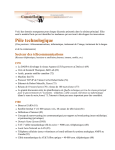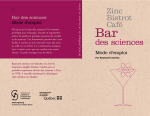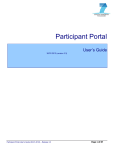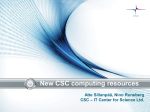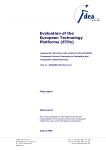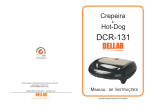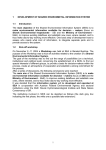Download summary analysis - European Commission
Transcript
Green Paper on a Common Strategic Framework for EU Research and Innovation Funding Analysis of public consultation EUROPEAN COMMISSION Directorate-General for Research and Innovation Directorate A – Framework programme & Interinstitutional relations Unit A.3 – Framework Programme & Simplification Contact: Marnix Surgeon E-mail: [email protected] EUROPEAN COMMISSION Green Paper on a Common Strategic Framework for EU Reseach and Innovation Funding Analysis of public consultation 2011 Directorate-General for Research and Innovation EUROPE DIRECT is a service to help you find answers to your questions about the European Union Freephone number (*): 00 800 6 7 8 9 10 11 (*) Certain mobile telephone operators do not allow access to 00 800 numbers or these calls may be billed LEGAL NOTICE Neither the European Commission nor any person acting on behalf of the Commission is responsible for the use which might be made of the following information. More information on the European Union is available on the Internet (http://europa.eu). Cataloguing data can be found at the end of this publication. Luxembourg: Publications Office of the European Union, 2011 ISBN 978-92-79-20325-1 doi 10.2777/58706 © European Union, 2011 Reproduction is authorised provided the source is acknowledged. Printed in Belgium GREEN PAPER ON A COMMON STRATEGIC FRAMEWORK FOR EU RESEARCH AND INNOVATION FUNDING : OUTCOME OF THE PUBLIC CONSULTATION Executive summary The public consultation on the Common Strategic Framework for EU research and innovation funding (launched on 9 February 2011) closed on 20 May 2011. The response to the consultation has been nothing less than overwhelming, with an unprecedented 775 position papers received and more than 1300 responses through the online questionnaire. The consultation website (http://ec.europa. eu/research/csfri) was visited nearly 90 000 times by over 38 000 unique visitors from 152 countries. Contributions were received from a wide range of stakeholders, the highest numbers coming from the research and higher education sectors, followed by the business sector and public administrations. Across all of these contributions, a number of messages are clear: • There is an overwhelming support for the CSF concept to bring research and innovation closer together, in order to enhance the impact of EU funding. • Simplification is considered to be a key priority for the Common Strategic Framework. • Respondents strongly support an approach which places EU funding for research and innovation close to societal challenges and therefore to the EU’s ambitious policy objectives in areas such as climate change, energy security and efficiency, demographic ageing or resource efficiency; • There are strong calls to maintain continuity as regards the elements of the current programmes which are considered to be the most successful, notably the European Research Council and Marie Curie actions, along with recurring messages on keeping collaborative research (centered on themes/challenges) as the core element of the future funding programme. • There is a recurring call for funding opportunities to be less prescriptive and more open, with sufficient scope for smaller projects and consortia, as these allow for more innovation. • In terms of creating more innovation, the main message is that the EU should support all stages in the innovation chain, with the appropriate instruments that are fit for purpose. • There is a shared view that all SMEs with innovation requirements should be able to benefit from EU research and innovation funding. • There is a widespread view that the CSF will need both curiosity-driven and agendadriven activities, working in tandem. Many point out that agendas should focus on main goals and principles. Also in the context of innovation, there is strong support for more bottom-up approaches. This document provides a summary analysis of the public consultation outcome. More in-depth question by question analysis, including the views of different groups of stakeholders, will be made available on the public consultation website in the coming weeks. 3 1. Background With the Green Paper ‘From Challenges to Opportunities: Towards a Common Strategic Framework for EU research and innovation funding1’ , the European Commission launched a public consultation on key issues to be addressed in developing future EU research and innovation funding programmes. The Green Paper proposed the concept of a Common Strategic Framework for all EU research and innovation funding to increase impact, make participation easier and more attractive and provide better value for money. Through the consultation, the Commission sought the view of all interested individuals and organisations on the concept of the Common Strategic Framework and on the specific questions set out in the Green Paper. The consultation ran from 9 February 2011 to 20 May 2011. Contributions were made in the following ways: • Through an online questionnaire based on the Green Paper; • Through the submission of consolidated position papers; • Through an interactive blog; • Through participation in specific events, where the Green Paper was discussed. During the consultation period, 1303 responses have been received through the questionnaire. In addition, 775 position papers have been received. This document presents a summary analysis of the responses received. 1 4 COM(2011) 48 2. Profile of respondents 2.1 Type of respondents The table below presents an overview of the type of respondents. It should be noted that these figures combine contributions made by both individuals on their own behalf and consolidated views of organisations such as universities, businesses, government bodies or associations. Questionnaire responses Position papers Total % of total Research and higher education 829 201 1030 49.57% Private sector 193 55 248 11,93% Government bodies 84 106 190 9.14% Other (associations, interest groups) 197 413 610 29.36% Total 1303 775 2078 100.00% About half of all contributions were made by the research and higher education sector. Considerable response was also received from associations and interest groupings. Only 12 % of all responses were submitted by individual companies. The predominance of responses from the research and higher education emphasises the need to complement the main messages contained in this document with a more in-depth analysis to investigate whether there are differing views among the main stakeholder groups. 5 2.2 Country of the respondents There was a broad geographical range of respondents, covering all EU 27 Member States as well as a significant number of other countries. The table below presents an overview of the country of origin (EU level organisations and international organisations counted separately) of the respondents to the public consultation, including both questionnaire responses and position papers. Country European Union International Austria Bulgaria Belgium Cyprus Czech Republic Denmark Estonia Finland France Germany Greece Hungary Ireland Italy Latvia Lithuania Luxemburg Malta Netherlands Poland Portugal Romania Slovakia Slovenia Spain Sweden 6 Number of responses 293 37 59 12 121 3 17 31 4 47 145 272 22 16 35 146 2 3 3 3 59 39 30 24 7 4 169 77 Percentage of total 14,0 1,8 2,8 0,6 5,8 0,1 0,8 1,5 0,2 2,3 7,0 13,1 1,1 0,8 1,7 7,0 0,1 0,1 0,1 0,1 2,8 1,9 1,4 1,2 0,3 0,2 8,1 3,7 United Kingdom Bosnia and Herzegovina Croatia Former Yugoslav Republic of Macedonia Iceland Israel Montenegro Norway Serbia Switzerland Turkey Other 248 2 1 11,9 0,1 0,0 1 0,0 7 5 2 27 3 55 9 41 0,3 0,2 0,1 1,3 0,1 2,6 0,4 2,0 2.3 Prior EU funding received Respondents to the online questionnaire were asked to indicate whether or not they had received prior funding from EU programmes. Some 18 % indicated not having received any priori EU funding. 65 % indicated having received funding through the Seventh Framework Programme, 16 % through the Competitiveness and Innovation Framework Programme and 43 % through another EU programme. 3. Importance of the questions Apart from being given the possibility to provide free text responses, respondents to the online questionnaire were asked to rate the importance of the questions in the online questionnaire, on a scale of ‘Very important - Important - Of some importance - Unimportant - Don’t know’. Combining the ‘Very important’ and ‘Important’ categories, the following five questions were considered to be the most important ones: 1. (Question 1) How should the Common Strategic Framework make EU research and innovation funding more attractive and easy to access for participants? What is needed in addition to a single entry point with common IT tools, a one stop shop for support, a streamlined set of funding instruments covering the full innovation chain and further steps towards administrative simplification? 2. (Question 2) How should EU funding best cover the full innovation cycle from research to market uptake? 3. (Question 7) What should be the measures of success for EU research and innovation funding? Which performance indicators should be used? 4. (Question 10) Should there be more room for bottom-up activities? 5. (Question 5) What should be the balance between smaller, targeted projects and larger, strategic ones? 7 In contrast, the following five questions were considered to be the least important ones, although it should be pointed out that this might be due to the fact that these questions relate to more specific aspects of EU research and innovation funding which many respondents do not have direct experience with. It should also be noted that in each case a majority of respondents still rate these questions as being either very important or important: 1. (Question 12) How should the role of the Commission’s Joint Research Centre be improved in supporting policy-making and forward-looking activities? 2. (Question 19) Should new approaches to supporting research and innovation be introduced, in particular through public procurement, including through rules on pre-commercial procurement, and/or inducement prizes? 3. (Question 24) What actions should be taken at EU level to further strengthen the role of women in science and innovation? 4. (Question 18) How should EU-level financial instruments (equity and debt based) be used more extensively? 5. (Question 17) How should open, light and fast implementation schemes (e.g. building on the current FET actions and CIP eco-innovation market replication projects) be designed to allow flexible exploration and commercialisation of novel ideas, in particular by SMEs? These results were further analysed to investigate whether there are differing views on the importance of questions amongst three stakeholder groups: research organisations, commercial organisations and public administrations: • Questions regarding the overall concept of the Common Strategic Framework, the integration of research and innovation and simplification were seen as very important by all stakeholders types; • Commercial organisations tended to attach greater importance to questions relating to closer to the market activities, to covering the whole innovation cycle, to specific measures taken to stimulate industry participation (such as Joint Technology Initiatives) and to increase SME involvement; • Research organisations typically pointed out the importance of questions related to frontier research, such as those on the European Research Council, Marie Curie actions or the need for more open and bottom-up funding schemes; • Public administrations attached greater importance to a range of more general questions relating primarily to programme design aspects such as the need to leverage other sources of funding, the links to other EU and national programmes or the balance between larger and smaller project types.. 8 4. Main messages 4.1 Working together to deliver on Europe 2020 The first block of questions in the Green Paper sought stakeholder issues on a number of important horizontal issues related to the proposed Common Strategic Framework. There is overall strong support for the basic aim of the Common Strategic Framework to bring research and innovation closer together in order to generate more impact from EU funding and to make it easier to access for participants. At the same time, many point out that there are different needs between research and innovation activities which need to be fully taken into account. ‘Euroscience agrees that conceptually it is a good idea to define EU policies for research and innovation in a comprehensive way’ (Euroscience) Respondents see the Common Strategic Framework as an ideal opportunity to simplify the EU funding landscape by reducing the number of instruments, removing overlap and improving the coordination with other sourcing of EU and national funds. There is strong agreement that collaborative research should continue to be the backbone of any future funding programme. ‘The EU funding landscape is currently extremely complicated… as a first step in rationalising, the Commission should carry out a thorough mapping of all EU instruments for research and innovation (FP7, CIP, EIT, others) to identify overlap, with a view to merging, reducing or adapting them accordingly.’ (Research Councils UK) In terms of creating more innovation, there is support for including more close to the market activities, such as applied research, demonstration projects, large scale trials, technology transfer or test beds. Several respondents argue that more emphasis should be placed on economic impact and market uptake. At the same time respondents often stress the importance of leaving sufficient room for unguided fundamental research and in particular for high risk and unconvential projects, which go beyond the main stream, as these have in the past proven to be able to produce unforeseen breakthroughs. Many respondents stress that closer to market activities require greater private sector involvement and financing, while this is not a requirement for fundamental research. A number of respondents called for schemes which would provide on-demand support to SMEs, enabling them to capture market opportunities in a more efficient manner. ‘Funding should focus more on support for implementation.(…)The support must help to close the gap to the market in order to achieve the marketability of innovations more quickly’ (Zentralverband des Deutschen Handwerks) 9 Other measures which are seen as beneficial to stimulating innovation include: proof of concept, better support services (training, brokerage, networking), stronger actions to improve dissemination and exploitation of results, an improved evaluation of innovation aspects in project proposals or a better understanding of innovation processes through socio-economic research, in view of increasing the impact of the EU’s funding programmes. A strong and continued push for more simplification came out as a top priority in order for the Common Strategic Framework to make EU research and innovation funding generate more impact and be more attractive to participants. In this respect, there was strong support for more coherence in the set of rules and procedures which governs EU research and innovation funding, while at the same time respondents stressed the need to maintain flexibility and to tailor rules to specific groups of beneficiaries, such as SMEs, where fast implementation and less jargon are essential to increase their participation. Continuity of the cost-reimbursement logic is preferred to a radical change towards out-put based grants. Many suggestions were put forward for reducing paperwork at all stages in the project cycle, with requests in particular for improved IT support. ‘The diversity of EU funding schemes with differing financial rules, rules for participation and rules regarding intellectual property makes EU funded research complex and inaccessible.’ (League of European Research Universities) A recurring concern across several of the questions of this block and indeed of the consultation as a whole is for calls to be less prescriptive and more open, with sufficient space for smaller projects and consortia. There is a widely shared conviction among the stakeholder community that this is a clear consequence of the stronger focus on delivering innovation. At the same time, many point out that the EU level has a unique role in supporting larger scale, strategic projects that cannot be properly supported at national levels. Many suggest an ‘ecosystem’ approach with a mix of smaller and larger projects which are able to interact with each other. Along the same line, more flexibility is also called for in the approach to project management, with a less strict definition of milestones and deliverables. Requests to relax the transnationality requirements associated to EU funding are also sometimes mentioned. ‘Individual projects should have more flexibility to adapt to market developments, thus retaining their relevance’ (Alcatel-Lucent) 10 Large, strategic, longer-term research and innovation actions are the tools many industrial and large innovation actors see as appropriate to tackle the grand challenges ahead. A coherent longerterm strategy would systematically combine research and innovation with finance, take-up and standardisation actions into focused ‘lighthouse’ projects that have the critical mass needed to generate a credible impact. ‘The CSF should identify a set of focused lighthouse projects that have critical mass and hence a true chance to create an impact on grand challenges’ (SAP) The Green Paper put forward a need for stronger efforts towards pooling Member State resources and leveraging other sources of public and private funding through the EU Budget. Respondents support this concept in order to create a critical mass of resources to tackle EU wide challenges, yet are also cautious to point out that other actors (national governments and the private sector) have in the past not always delivered on their commitments in this respect and that such approaches should not lead to increased administrative complexity. There are also several requests to further clarify the way in which Joint Programming Initiatives will be supported and to ensure that no Member States are excluded from participating. ‘The Common Strategic Framework should provide co-funding for proposed activities to encourage Member State organisations to coordinate their activities, whilst recognising the need for flexibility and creativity in implementation and no rigid one size fits all approach.’ (Eurohorcs) A majority of respondents call for using a wide range of performance indicators for EU research and innovation funding programmes. These should mix both scientific and technological indicators and measures of commercial impact. In defining these indicators, the Commission should not re-invent the wheel, but rely on existing indicators, while also exploring new territory. There is a clear signal coming from the consultation that excellence needs to remain the key criterion for distributing EU research and innovation funding. Respondents stress that projects funded through the Common Strategic Framework need to continue to be selected on a competitive basis and through peer review. At the same time, respondents stress that the Structural Funds should be used to unlock the full research potential of Europe. There is strong support for more coordination between the different EU instruments to avoid duplication and exploit synergies. ‘The excellence of projects should remain the primary criterion in the adoption of decisions on financing scientific research. All EU researchers should have the opportunity to reach excellence and compete for the best financing opportunities.’ (Estonian government) 11 4.2 Tackling societal challenges The second block of questions in the Green Paper invited stakeholder views on the implications of a shift towards a funding approach which is increasingly based on contributing to the EU’s ambitious policy objectives in areas such as climate change, energy security and efficiency, demographic ageing or resource efficiency. There is a widespread view among stakeholders that effectively tackling societal challenges requires continuing to strike a balance and complementarity in funding between activities where the agenda is pre-set by policy makers and those where it is the curiosity of researchers and innovators which defines the scope of the activities. In this context, Joint Programming between Member States and the EU is seen as an important way of creating high European added value. ‘Even for agenda-driven activities, societal challenges should be broadly defined in order not to restrict too much the spectrum of areas that researchers can explore.’ (Microsoft UK) Although industry stakeholders show stronger support for activities with clear agenda setting, this is accompanied by a call towards policy makers to refrain from setting the agenda beyond the main objectives and outcomes to be achieved, leaving it up to the participants themselves to put forward the most appropriate solutions to tackle the challenge at hand. Many respondents feel that this is the only way to unlock the creative potential of Europe in high-risk, but also high-pay off projects. ‘The Common Strategic Framework must have the degree of flexibility that is necessary for adjustments of research priorities during the whole programme period. What is now identified as a societal challenge will maybe not, in a couple of years, be considered as the most important ones’ (Swedish Government) Similarly, there is strong support for the bottom-up elements of the current funding programmes (e.g. European Research Council, SME specific actions or Marie Curie actions), which are deemed to be among the most successful and are widely appreciated among the stakeholder community. There is frequent mentioning of more open calls also being needed in the typical thematic programmes focusing on collaborative research, with many stakeholders pointing out how this would be beneficial for new participants and in particular for SMEs. ‘More extended use of a bottom-up approach should be encouraged in the thematic programmes, making funding available not only for specific research fields. A bottom-up approach is also more suitable for SMEs’ (Hungarian government) 12 Respondents indicate the need to actively foster the dialogue between policy makers and researchers. Funding excellent research and actively promoting the dissemination of project outcomes, also to policy makers are seen as the most efficient ways for EU research and innovation funding to contribute to achieving the EU’s overall policy objectives. For those that provided views on the Joint Research Centre, there is overwhelming support for its role as the Commission’s in-house scientific service to continue and reinforce its scientific advice to EU policy making, to further increase its cooperation with Member States, industry and the scientific community, and to enhance its visibility through better communication and dissemination of results. ‘The UK supports the role of the Joint Research Centre in providing scientific and technical advice to inform EU policy and legislation.’ (Department for Business, Innovation and Skills, UK Government) Many respondents stress the need to interact more directly and more closely with citizens and civil society. Suggestions on how to achieve this touch upon science education, science information, clear communication and promotion of science, with a clear role being attributed in this endeavour to the regional and national policy levels. Beyond these classical approaches, many contributions suggests that citizens and civil society should be directly involved in the whole chain of research and innovation, e.g. through citizens’ juries, participatory research projects, assessment of research results, focus groups, communities of practice, forum, investigations into the advance of moral aspects, etc. One of the discussions on the interactive blog raised the issue of using crowd sourcing techniques. 4.3 Strengthening competitiveness The third block of questions invited stakeholders’ views on how EU research and innovation funding can assist in strengthening the competitiveness of Europe’s industry. More openness in defining calls and call topics and giving industry participants the chance to put forward solutions on the basis of their experience and an assessment of market needs is strongly supported by respondents as a crucial element in a push for more innovation. Furthermore, it is stressed that innovation requires multi-disciplinary approaches and therefore a broadening of the scope of the funding programme towards a wider variety of calls for proposals addressing different elements of the innovation cycle, and in particular for extending the scope of funding towards closer to market activities. Respondents feel that technological innovation alone is inadequate to address the complexities of the grand societal challenges. There is a need to embrace a broad concept of innovation, including non-technological and non-research based innovation and activities such as design, creativity, service, process and business model innovation. There appears to be agreement that eco-innovation may deserve specific attention. 13 ‘It is misguided to consider innovation as a purely linear process, starting from research and ending at the market. On the contrary, innovation is often a non-linear process and occurs in many businesses that are non research based. EU funding must embrace and facilitate the many forms of innovation’ (Eurochambres) There is widespread support for a greater involvement of industry in EU research and innovation programmes. Further simplification is equally seen as a key priority towards increasing industrial participation in EU research and innovation funding programmes, and would be particularly beneficial for SMEs. Several respondents emphasise that currently companies are not willing to invest in EU funding programmes as they are being perceived as too complex and to costly to participate in. Industry in particular stresses the need of a strong SME support and network mechanism building upon the Enterprise Europe Network. ‘The financial rules and levels of bureaucracy, the lead time from proposal to funding, together with the very specific levels of expertise needed to stand any chance of success with the application process, all act as barriers to business participation in programmes.’ (Business Support Kent) The European Technology Platforms are generally seen as a valuable tool in ensuring that industrial priorities are well reflected in EU funding programmes. Joint Technology Initiatives, on the other hand, are perceived somewhat less positively, with some respondents criticising their legal structure and rules which are in need of optimisation to make them fit for purpose. The public-private partnerships which were set up in the context of the European Economic Recovery Package are an alternative approach which is advocated frequently. ‘Efforts must be made to simplify the complex structures of the existing JTIs, for example through the broad application of public private partnerships like that emerged under the EU stimulus plan.’ (German Federal Government) There is a shared view among respondents that all SMEs with innovation requirements should be able to benefit from EU research and innovation funding, with strong support to maintain an SME specific part in the Common Strategic Framework. In this context, mention is made of dedicated and more open calls in thematic collaborative research activities, of activities which operate closer to the market, but also again of a more general need for further simplification and 14 adequate support structures. Both the current 15% target for the FP7 Cooperation programme and the Eurostars Article 185 initiative are mentioned sporadically, but do not receive overwhelming support. ‘From the SMEs’ point of view, the simplification of application, project management and funding procedures is important and different types of “light and fast” schemes should be favoured’ (TEKES) Some contributors support the opportunities provided by novel financial instruments and feel they can fulfil an increasingly relevant and important role for funding certain categories of RDI. There is some reluctance among stakeholders to introduce novel approaches, with some calling for a moratorium on introducing new instruments. Some stress the importance of shifting towards demand driven approaches, with public procurement in general receiving wider support than the introduction of inducement prizes and awards. Industry in particular recognises the untapped potential of the public sector’s purchasing power and calls for supporting both pre-commercial procurement and public procurement of innovation. ‘Public procurement should become a way though which the public sector leads by example, making sure that the latest technologies can be developed.’ (Confederation of European Paper Industry) The current provisions on Intellectual Property Rights are judged to be adequate, with many respondents stressing the need to ensure proper dissemination and exploitation of results. In this context, there is support for open access approaches, where the free dissemination of publicly funded research results is the rule, although the difficulty in striking a good balance between IPR protection and openness is generally acknowledged. One of the interactive blog discussions considered the benefits and limitations of using inducement prizes. 4.4 Raising the excellence of the research base and completing ERA The fourth and final set of questions invited views on how the European science can be stimulated towards a higher level of excellence and how EU funding can assist in completing the European Research Area. In this context, there is very strong support for the European Research Council (ERC) and overall satisfaction with its current functioning. Several respondents mention explicitly the need to further increase its funding levels, while maintaining its focus on excellence and ensuring its independence from outside influence. Yet at the same time, there are some voices of concern over the ERC’s overreliance on quantitative indicators such as publications in top journals. As regards future activities, there is repeated mention of the need for a third funding stream for ‘consolidating’ researchers (in between the current starting investigator grant and advanced investigator grant) and to put greater emphasis on attracting third country researchers. 15 ‘Although the ERC is only of indirect benefit to the business sector, substantial investments in frontier research are essential for Europe’s future and the ERC has to be continued in the CSF.’ (BusinessEurope) Several respondents highlighted that more effective links need to be established between curiositydriven research and the different phases of the research-innovation chain, to favour a smooth and continuous flow of novel ideas into innovative products and services. In this respect, collaborative schemes such as the Future and Emerging Technologies scheme have been mentioned to be effective in raising research excellence and in path finding and maturing new research avenues into mainstream research and innovation. ‘It is vital to maintain and expand the ‘Future and Emerging Technologies’ (FET) scheme from ICT to the other areas.’ (Commissariat à l’Energie Atomique) Providing researchers with a stairway to excellence is seen primarily as a role for national and regional governments, with EU research and innovation funding needing to keep a strong focus on quality as its basic criterion for distributing funding. Member States should be encouraged to harmonise their policies to increase the impact of research and innovation funding across Europe. A homogeneous and well balanced development of the European Research Area is the best way forward to spread excellence in Europe in its entirety. Respondents feel the EU, notably through the Structural Funds, can assist Member States and regions in this endeavour. This could include further promoting the development of smart specialisation strategies, developing common standards for university systems or a closer monitoring and evaluation of national and regional policies, for instance through an improved ERAWATCH system. The Marie Curie actions for mobility and training of researchers are generally considered to be one of the most successful and most widely appreciated elements of the current Framework Programme. There is frequent mentioning of the need to increase funding levels for these actions and also of the need to maintain their bottom-up character. Many interesting suggestions were also made to further develop the particular Marie Curie schemes. ‘The Marie Curie Actions have been for many years amongst the most popular, competitive and useful EU-funded instruments and their role should be maintained and further enhanced under the next framework programme’ (CERN) 16 Respondents stress that gender balance (i.e. the equal participation of women and men in research activities at all levels) as well as gender dimension should be fully integrated in all aspects of the Common Strategic Framework, while underlining that this mainstreaming approach needs to be paralleled by specific actions and budget. ‘Europe needs excellent science and innovation to tackle the Grand Challenges. All resources are needed. Irrespective of age, race or gender, ERA should exploit all available talents and to that end, specific instruments should be employed.’ (European Research Area Board) Large scale research infrastructures, including e-Infrastructures, are judged to be a core element of the EU’s research and innovation landscape and support to them should therefore be strengthened both financially and strategically. Respondents frequently mention the need to foresee sufficient resources to implement the ESFRI roadmap, including through the Structural Funds, and the importance of providing transnational access to existing infrastructures. Regarding e-Infrastructures, many respondents highlighted them as enablers for new ways of conducting research across scientific communities and geographic and administrative boundaries. They also stress the need to enhance the impact of research infrastructures on innovation by fostering the involvement of industry and to better exploit the potential of e-Infrastructures as knowledge and innovation enablers. ‘Open access to large scale research infrastructures needs to be secured in the next funding period.’ (Cypriot government) Tackling societal challenges at the global level and supporting the EU’s strategic interest are seen as the key drivers for developing an international cooperation strategy for the Common Strategic Framework. In this context, frequent mention is made of the need to establish more cooperation with industrialised countries and to pursue equal partnerships and reciprocity, in particular in terms of participation and funding. ‘International cooperation activities should address the global challenges allowing Europe to participate to global solutions.’ (Italian Agency for the Promotion of Research) As regards tackling obstacles to the European Research Area, mention is most frequently made of the issues of mobility of researchers, improving researchers’ careers, broadening access to scientific data (with e-Infrastructures being key in achieving an ‘on-line’ ERA in which knowledge flows freely), increasing access to research infrastructures, improving cooperation with external actors or taking further steps towards a better coordination of research and innovation policies across Europe. Some respondents mention the need to take legislative measures to harmonise national policies. 17 European Commission Green Paper on a Common Strategic Framework for EU Research and Innovation Funding Analysis of public consultation Luxembourg: Publications Office of the European Union ISBN doi 978-92-79-20325-1 10.2777/58706 2011 — 20 pp. A4 — 21 x 29,7 cm How to obtain EU publications Free publications: • via EU Bookshop (http://bookshop.europa.eu); • at the European Commission’s representations or delegations. You can obtain their contact details on the Internet (http://ec.europa.eu) or by sending a fax to +352 2929-42758. Publications for sale: • via EU Bookshop (http://bookshop.europa.eu); Priced subscriptions (e.g. annual series of the Official Journal of the European Union and reports of cases before the Court of Justice of the European Union): • via one of the sales agents of the Publications Office of the European Union (http://publications.europa.eu/others/agents/index_en.htm). KI-30-11-138-EN-C This document provides a summary analysis of contributions received in response to the public consultation on a Common Strategic Framework for EU research and innovation funding. This public consultation was launched on the basis of a Green Paper entitled ‘From Challenges to Opportunities: Towards a Common Strategic Framework for EU research and innovation funding’. Over 2.000 organisations, scientists, entrepreneurs and other individuals provided a response. The Common Strategic Framework will bring together funding currently provided through the Framework Programme for Research (FP7), the innovation actions of the Competitiveness and Innovation Framework Programme (CIP) and the European Institute of Innovation and Technology (EIT). The aim is to make EU research and innovation funding easier to access, increase its scientific and economic impact and provide better value for money. The Common Strategic Framework also provides the basis for far-reaching simplification of procedures and rules. The results of the consultation, including the discussions during the 10 June 2011 conference, will feed into the development of the Commission’s legislative proposals for research and innovation spending under the future EU budget post-2013. These proposals will be presented at the end of 2011. For further information: http://ec.europa.eu/research/csfri © European Union, 2011 – Reproduction is authorised provided the source is acknowledged.
























